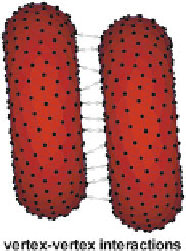Biomedical Engineering Reference
In-Depth Information
the sheared fluid can be found as follows
F
D
dV
F
v
=
ng
(
r
)
,
(10.25)
V
h
where
F
D
is the DPD dissipative force [53] between fluid particles and membrane
vertices,
n
is the fluid number density,
g
is the radial distribution function of fluid
particles with respect to the wall particles, and
V
h
is the half sphere volume of fluid
above the wall. Here, the total shear force on the area
A
is equal to
N
A
F
v
,where
N
A
is the number of wall particles enclosed by
A
. The equality of
N
A
F
v
=
(
r
)
results
in an expression of the dissipative force coefficient in terms of the fluid density and
viscosity, and the wall density
N
A
/
A
η
γ
˙
A
, while under the assumption of linear shear flow
the shear rate
˙
cancels out. This formulation results in satisfaction of the no-slip BCs
for the linear shear flow over a flat plate. It also serves as an excellent approximation
for no-slip at the membrane surface in spite of the assumptions made. Note that in
the absence of conservative interactions between fluid and wall particles
g
γ
(
r
)=
1.
10.2.3.4 RBC aggregation interactions
For a blood suspension the attractive cell-cell interactions are crucial for simulation
of aggregation into rouleaux. These forces are approximated phenomenologically
with the Morse potential given by
D
e
e
2β
(
r
0
−
r
)
−
2
e
β
(
r
0
−
r
)
φ
(
r
)=
,
(10.26)
where
r
is the separation distance,
r
0
is the zero force distance,
D
e
is the well depth of
the potential, and
characterizes the interaction range. For the MS-RBC model the
Morse potential interactions are implemented between every two vertices of separate
RBCs if they are within a defined potential cutoff radius
r
M
as shown in Fig. 10.3.
The Morse interactions consist of a short-range repulsive force when
r
β
<
r
0
and of a
long-range attractive force for
r
r
0
. However, such repulsive interactions cannot
prevent two RBCs from an overlap. To guarantee no overlap among RBCs we em-
ploy a short range Lennard-Jones potential and specular reflections of RBC vertices
>
Fig. 10.3.
Aggregation interactions for the MS-RBC model

